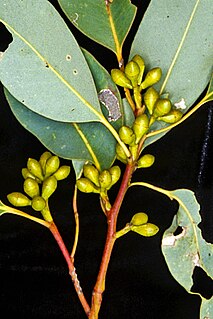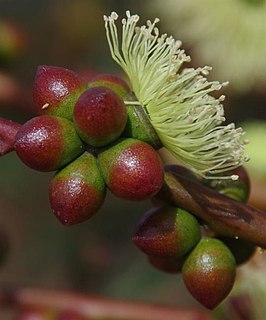
Eucalyptus falcata, commonly known as silver mallet or toolyumuck, is a species of mallee or marlock that is endemic to Western Australia. It has smooth bark, lance-shaped to curved adult leaves, flower buds in groups of eleven or thirteen, creamy white or yellowish green flowers and flattened spherical fruit.

Eucalyptus goniocarpa is a species of mallet, that is endemic to southern Western Australia. It has smooth bark, glossy bluish adult leaves, flower buds in groups of three, creamy-white flowers, and ribbed, conical to barrel-shaped fruit.
Eucalyptus optima, is a species of small to medium-sized tree or a mallet that is endemic to a small area in the south of Western Australia. It has smooth white to greyish bark, sometimes with rough black bark on the base of the trunk, lance-shaped adult leaves, flower buds in groups of seven or nine, pale yellow flowers and cup-shaped, hemispherical or urn-shaped fruit.
Eucalyptus × phylacis, commonly known as the Meelup mallee, is a species of tree or a robust mallee that is endemic to a small area in the southwest of Western Australia. It has rough, hard and corky bark on the trunk and larger branches, lance-shaped or curved adult leaves, flower buds in groups of eleven, creamy white flowers and hemispherical fruit. It is possibly a hybrid between E. decipiens and E. virginea.

Eucalyptus pruinosa, commonly known as silver box, silver leaf box, apple box or smoke tree, is a species of tree or a mallee that is endemic to northern Australia. The Jaminjung peoples know the tree as yarrirra or jarnbiny, the Jaru as wararn and the Wagiman as wararn. It has rough, fibrous to flaky bark on the trunk and branches, a crown composed of juvenile, glaucous, heart-shaped to broadly elliptical leaves arranged in opposite pairs, flower buds arranged in groups of seven on the ends of branches, creamy white to pale yellow flowers and cylindrical to conical fruit.

Eucalyptus sargentii, commonly known as Salt River gum, is a species of mallet, mallee or small tree that is endemic to Western Australia. It has rough bark on part or all of the trunk, smooth bark above, linear to narrow lance-shaped leaves, flower buds in groups of seven, whitish to creamy yellow flowers and conical fruit.
Eucalyptus tortilis is a species of mallet and a gimlet that is endemic to the southwest of Western Australia. It has smooth bark, lance-shaped adult leaves, flower buds in groups of seven, creamy white flowers and hemispherical to cup-shaped fruit.
Eucalyptus urna, commonly known as merrit, is a species of mallet or marlock that is endemic to southern areas of Western Australia. It has smooth bark, lance-shaped adult leaves, flower buds in groups of seven to thirteen, creamy yellow to white flowers and urn-shaped fruit.
Eucalyptus valens is a species of mallet, a tree lacking a lignotuber, that is endemic to near-coastal areas of southern Western Australia. It has smooth bark, lance-shaped adult leaves, flower buds in groups of seven and cup-shaped fruit.

Corymbia collina, commonly known as the silver-leaved bloodwood, is a species of tree that is endemic to Western Australia. It has thin patchy rough bark on some or all of the trunk, smooth white to pale grey bark above, lance-shaped to curved adult leaves, flower buds in groups of seven, creamy white flowers and barrel-shaped fruit.

Corymbia ferriticola, commonly known as the Pilbara ghost gum, is a species of tree or a mallee that is endemic to Western Australia. It has smooth bark, lance-shaped adult leaves, flower buds in groups of seven, creamy white flowers and shortened spherical to cylindrical fruit.

Corymbia bloxsomei, commonly known as yellowjack, yellow jacket or yellow bloodwood, is a species of tree that is endemic to inland, south-eastern Queensland. It has thick, rough scaly bark on the trunk and larger branches, lance-shaped or curved adult leaves, flower buds in groups of seven, nine or eleven, creamy white to pale yellow flowers and barrel-shaped, urn-shaped or spherical fruit.
Corymbia leptoloma, commonly known as the yellowjacket or Paluma Range yellowjacket, is a species of tree that is endemic to Queensland. It has rough, tessellated bark on the trunk and branches, lance-shaped or curved adult leaves, flower buds in groups of seven and barrel-shaped, urn-shaped or shortened spherical fruit.

Corymbia nesophila, commonly known as the Melville Island bloodwood, is a species of tree that is endemic to northern Australia. It has rough, tessellated bark on the trunk and branches, lance-shaped or curved adult leaves, flower buds in groups of seven, creamy white flowers and urn-shaped fruit.
Corymbia xanthope, commonly known as Glen Geddes bloodwood, is a species of tree that is endemic to a small area of Queensland. It has thick, rough bark on the trunk and branches with yellow bark visible underneath, lance-shaped to curved adult leaves, flower buds in groups of seven, creamy white flowers and urn-shaped fruit.
Eucalyptus costuligera is a species of small tree that is endemic to the Kimberley region of Western Australia. It has short-fibrous or flaky bark on the trunk and branches, bluish, lance-shaped adult leaves, club-shaped flower buds in branched or unbranched inflorescences with the buds in groups of up to seven, creamy-white flowers and conical, cup-shaped or pear-shaped fruit.

Eucalyptus grisea, commonly known as grey gum, is a species of tree that is endemic to central Queensland. It has smooth greyish bark, lance-shaped to egg-shaped adult leaves, flower buds in groups of seven, white flower and usually cup-shaped fruit.

Eucalyptus terebra, commonly known as Balladonia gimlet, is a species of gimlet that is endemic to Western Australia. It has satiny or glossy bark on its fluted trunk, linear to narrow lance-shaped adult leaves, flower buds in groups of seven, yellowish flowers and conical to hemispherical fruit. It is one of the seven species of gimlet.
Eucalyptus purpurata, commonly known as the Bandalup silver mallet, is a species of mallet that is endemic to a small area in the southwest of Western Australia. It has smooth, silvery bark, glossy dark green, lance-shaped adult leaves, flower buds in groups of between seven and eleven, creamy white flowers and shortened spherical fruit.

Eucalyptus socialis subsp. eucentrica, commonly known as the inland red mallee, is a subspecies of mallee that is endemic to inland Australia. It usually has rough bark on the base of the trunk, smooth bark above, lance-shaped adult leaves, flower buds in groups of between seven and eleven, pale creamy yellow flowers and barrel-shaped to urn-shaped or spherical fruit.











